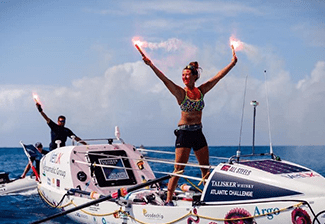Going It Alone: 21-year-old Becomes the Youngest Woman Ever to Row Solo Across any Ocean
Medium,

The alarm fired off at 4 a.m., and Jasmine Harrison, 21, knew what it meant. She sprinted out of her bunk to see what it was that had triggered the warning that another vessel was coming dangerously close to her 21-foot Argo boat. Looking up, she quickly got her answer: The Stena Forth, a 745-foot long drilling ship, was less than a quarter-mile away. It was headed directly toward her.
She quickly radioed the captain. When there was no answer, she radioed again, holding flares in case they were needed. She turned her boat due south. Finally, on the third call, she heard a voice: “How far away are you?” Her reply was direct: “Literally right under you.”
As it happened, the Stena Forth was traveling quite slowly and was able to turn north, a catastrophe avoided. It is fair to say that the ship’s captain did not anticipate running across a 21-year-old Brit in a tiny rowboat, floating in the middle of nowhere in the Atlantic Ocean.
To that end, the captain and Harrison would have been on the same page. A few years ago, Harrison would not have expected to be there either. A pentathlete, an avid swimmer and sailor, this bartender/swim instructor nevertheless was at that point doing something completely new for her. As she later told me in an interview, “Never. Never rowed in my life.”
But there she was, on that vast body of water, doing what she could to avoid her boat getting split in half by a drilling ship. And eight days ago, the point of that exercise, that journey, was driven home in record-setting fashion.
As part of the Talisker Whiskey Atlantic Challenge, a premier rowing event, Jasmine Harrison became the youngest female ever to row solo across the Atlantic, covering 3,000 miles. Going from La Gomera in the Canary Islands to Antigua in the Caribbean, she clocked in at 70 days, 3 hours and 48 minutes, during which it is estimated that she rowed 1.5 million strokes.
Departing on Dec. 12 as one of just 21 contest entrants that ranged from four-man crews to soloists, Harrison became one of only 18 women to ever successfully cross the Atlantic in a rowboat. The prior youngest female solo record holder was an American, Katie Spotz, who crossed in 2010 at age 22.
It was an epic adventure, including plenty of misadventure. Her boat capsized twice. Bad weather cost her more than two weeks, by her estimation. She at times rowed in circles, and even went backward at one point nearly 30 miles, despite supposedly being held fast by the boat’s para-anchor. Bashed around in her cabin by giant waves, she suffered an elbow injury.
To Harrison, though, it was a beautiful journey, filled with unexpected moments of clarity and grace. More to the point, it was a challenge accepted — and met.
“I just knew I could,” she told me. “I spent so long convincing myself that this is what I wanted to do. When I actually set my mind to something, it’s going to be done. Just give me time. I’ll get it done eventually.”
The seed was planted in 2018, when, after sailing to Antigua, Harrison chanced at a bar to meet the family member of a Talisker rower, who suggested that Harrison come watch the end of the race. Beguiled by what she witnessed, she says she told herself aloud, “’I’m going to do that one day.’ And then I spent a year actually kind of convincing myself that I wanted to do it.”
“I knew she meant it,” said her mother, Susan Harrison, whom Jasmine informed of her decision. “I was hopeful that she didn’t really mean as a solo, but she did.”
The North Yorkshire native did not begin training until January of 2020, and it wasn’t long before she met her first challenge: staying in shape during a pandemic. The COVID-19 lockdown closed her gym; fortunately, Harrison said, she had a key, permission and determination.
“What Jasmine has achieved is completely awesome, every step of the way, from launching her land-based campaign, getting sponsors on board, to buying the boat and all the training, to the actual row,” said Susan Harrison. “I never had any doubt that she would do it. It would only have been external factors that could have stopped her, but she even defied the odds there.”
Still, her daughter did not get her boat until July 2020, and had just four and half months to record the 120 hours of mandatory rowing practice required of all race participants. And no practice could have prepared her for 70 days on the ocean, alone.
Harrison had navigation and a satellite phone, which race officials used to contact her for a safety check each day and to update weather conditions. She ate biscuits and went through about 40 kilograms (about 88 pounds) of chocolate, used the phone to callfriends and “her mum,” and read some of Ross Edgley’s Art of Resilience (a book she could likely author now). Mostly, though, she worked, rowing 12 hours a day, sometimes going through the night when ocean and weather conditions favored that schedule.
“It’s the most amazing place any person could ever be,” Harrison said. “The ocean is so big; you never see another boat. I have crossed a part of the world, many parts of the world, where no one who is human has ever been. No fish could have swum this far. It’s just absolutely vast and beautiful.
“Every single day is different. I’d wake up every day and it felt like I was on a different ocean: the waves are different, the wind’s different, the sun, literally everything. You feel different as well.”
The boat, its contentsand Harrison were repeatedly soaked by waves, some of which she estimated at 50 feet, but the work continued. The Argo capsized twice under heavy waves, once in early February and again just two days before Harrison’s anticipated finish. The boat has a self-righting feature, which worked both times, but the second incident hurled Harrison around inside her cabin (“think of being inside a human-sized washing machine…”)and injured her left elbow so significantly that she could not row properly for a day “because I couldn’t bend it.”
But that is not how she remembers the sojourn. As Harrison describes it, the scene is visual as much as physical. She saw “weird, wonky triggerfish,” flying fish, striped marlin, a pod of Risso dolphins with which she swam, whales that came right up to the Argo. She remembers epic sunrises and sunsets, full moons, shooting stars, the bright bioluminescence of ocean creatures at night.
She avoided seasickness — but not the seasickness patch, which was supposed to prevent such a thing. Instead, Harrison said, wearing the patch early in the voyage caused her to hallucinate. “I lost my ‘short sight,’ but I just rowed blind anyway. I couldn’t see my navigation,” she said. “You should have seen my tracker: I was maneuvering backwards, up, down, left, right.” She lost two days while rowing in a circle.
And there was, of course, the down time. Seventy days is a fair stretch to spend with one’s own thoughts. For Harrison, it was a time of personal reckoning.
“I started going through my entire life,” she said. “Actually, I started from my earliest memories, trying to decipher who I am and why I’m here right now, which is quite interesting to work out. It was a bit deep, actually…You invent things as well, make up stories. And my brain goes a hundred miles an hour all the time — and honestly, it never stopped the entire time either. I just had so many ideas and thoughts.”
On her Facebook feed, there’s a terrific video of Harrison singing a simple song about the trails of seaweed in the ocean: “Follow the yellow weed road, follow the yellow weed road.” As she told me, “The song literally repeats that line over and over again, so that passed time really well.”
“Mentally, I was okay, because I’m chill with whatever,” Harrison added. “If it is something physical, I know that that’s my strength. You know yourself on the inside. I know my abilities. And I knew that I would be able to learn pretty quickly and be able to do this.”
After the autohelm on the Argo ceased functioning on Day 20 of the race, Harrison had to manually steer the rest of the way. Because one can’t control the rudder and paddle the oars at the same time, Harrison figures she lost over 5 miles a day. “I probably could have saved a week altogether. There’s just so many variables.”
None of those variables, in the end, kept Harrison from the record finish. She didn’t sleep the night before sailing into English Harbour in Antigua, in part because she wanted to row through the night and stay on course so she didn’t miss it. Holding flares in the air as she crossed the finish, smiling brilliantly, Harrison was handed a banner: “New World Record.” It was hers and hers alone.
“I am incredibly excited to see a young female in our race, inspiring people all over the world,” said Carsten Heron Olsen, CEO and Talisker race director. “That’s the beauty of this race — the inspiration and the great stories that come from it — and Jasmine is a great ambassador for just that.”
Asked if she’d consider covering the course again, Harrison quickly replied, “Yes. It would be amazing.” At the same time, she said, the race is becoming more popular, and she doesn’t want her entry to crowd out a first-timer. “I want to let other people see the world that I’ve seen,” she said.
Her hope, Harrison said, is to inspire young people to achieve their dreams on their own. In the meantime, “There are so many other cool things in the world to do — so many amazing challenges.” The odds strongly suggest that Jasmine Harrison, who came out of nowhere to set a world record, will soon be associated with some of them.
